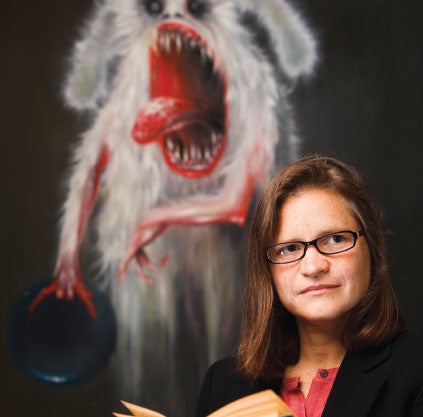 You are surrounded. There’s no hiding. No escaping. No fighting or defending. You can try to ignore them, but they’re always lurking – and not just underneath the bed.
You are surrounded. There’s no hiding. No escaping. No fighting or defending. You can try to ignore them, but they’re always lurking – and not just underneath the bed.
From the zombies of The Walking Dead to the vampires of Twilight: Monsters are everywhere you look. And – as Kathleen Béres Rogers will tell you – they’re not going away.
“Monsters are part of what makes us human – they’ve been a part of culture and society from the beginning. What changes is what is considered monstrous,” says the English professor, whose course, Monsters and Monstrosities, explores everything from Beowulf and The Elephant Man to The Walking Dead and I Am Legend, analyzing how monsters manifest in various expressions of human culture throughout history.
“Monsters are reactions to societal and cultural fears. It all comes down to the other, those non-normative things that we are afraid of in society and in ourselves,” says Rogers, who – as a first-generation American growing up in upstate New York – has herself been “othered”: “Not only can I joke with my students about my ‘fangs,’” she laughs, referring to her mother’s roots in Transylvania, “but I know what it was like for my parents to be labeled as ethnic others.”
That is, after all, only natural: Every community has its outsiders.
“You have sororities, you have the gaming culture, the BMX biker community, independent farmers: Every discourse community has its cultural norms and creates social others,” says Rogers, whose students each choose a discourse community to analyze, paying special attention to the social “monsters” they create. “Whether it’s special needs children or disabled people, people of different sexualities – throughout history, we have tried to keep our ‘monsters’ hidden away, to separate them from ourselves.”
That’s why, she says, the monsters that can walk among us, that aren’t always recognizable, are particularly terrifying.
“Werewolves represent that hybridity, for example. What is it? It’s hard to distinguish between the animal and the person, because they are neither one or the other,” she says. “It also raises fears of what’s inside us, because all of us have the elements of monstrosity within us – and we can’t constrain the binary of normal and not normal.”
This blend of “normal” and “not normal” plays into cultural fears of transgendered and bisexual people – topics that interested several of her students.
“My final paper addressed the erasure and invalidation of bisexuality in LGBT-plus spaces,” says Jessie Covington, a senior mathematics major. “I looked at a couple of popular LGBT-specific TV shows and their portrayal (or lack thereof) of bisexuality and how these shows furthered stereotypes while alienating part of their audience demographic in a space that is supposed to be inclusive.”
Ultimately, Rogers says, society will continue to try to alienate the other – whatever that may be at that place and time – proving itself just as monstrous as the monster it creates, if not more so.
And so, no: Monsters aren’t going anywhere any time soon. You can try to run, try to hide, but they’ll always be lurking nearby. The good news is, they make for great entertainment.
– Photo by Kip Bulwinkle ’04




